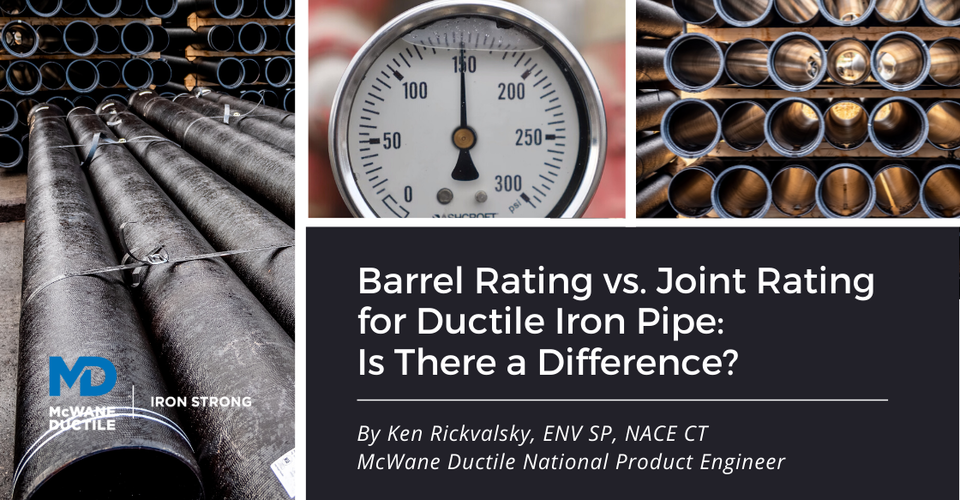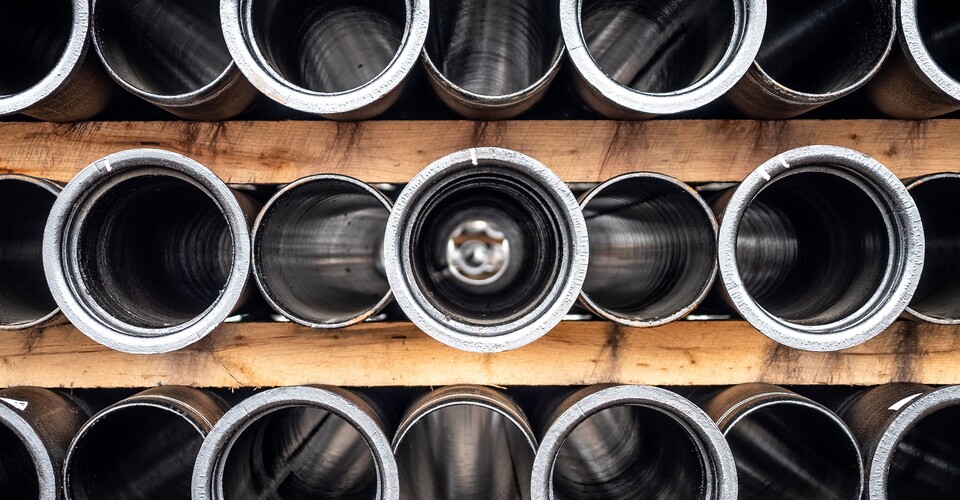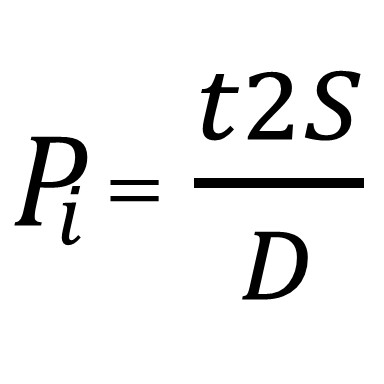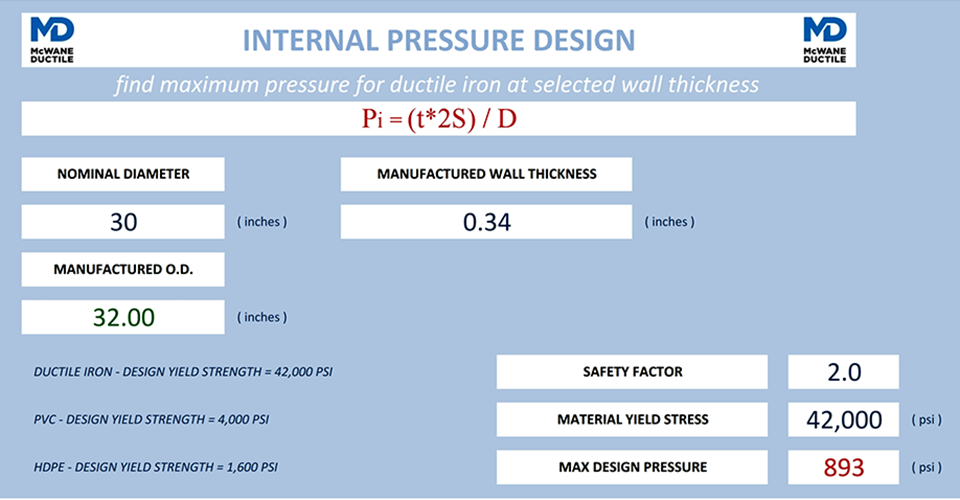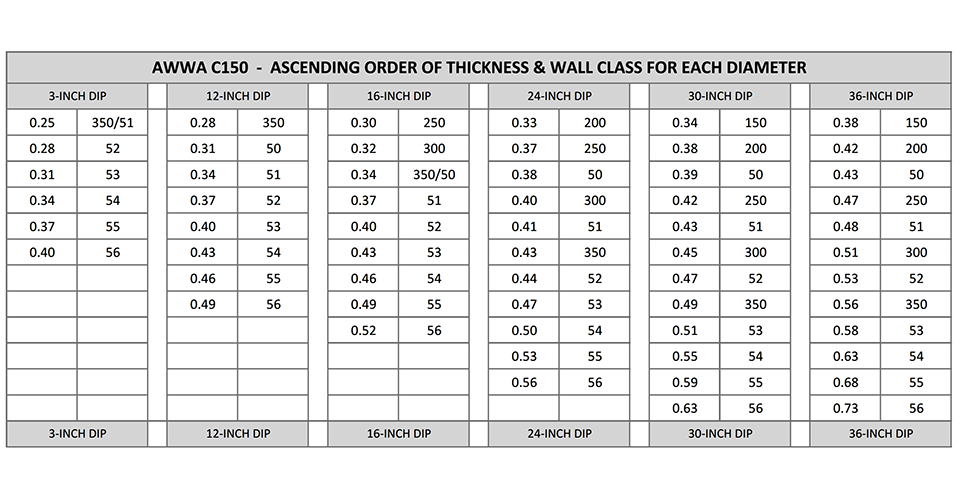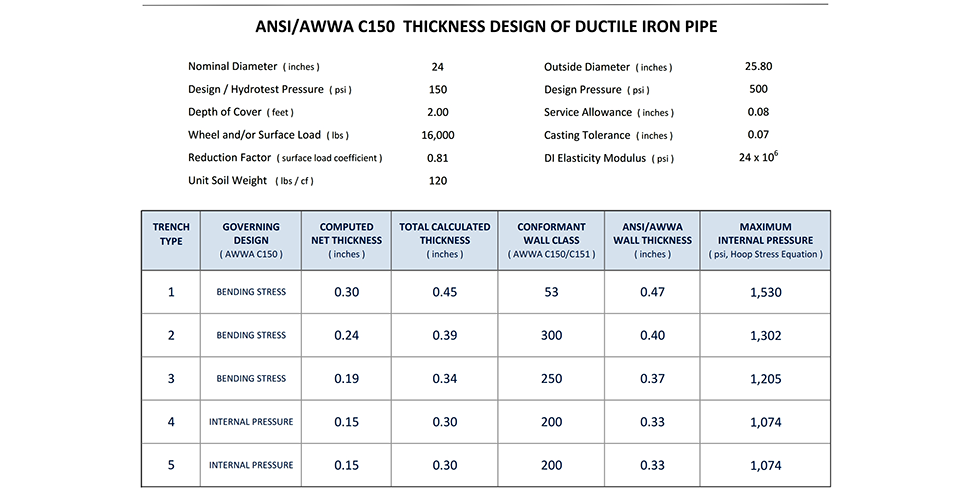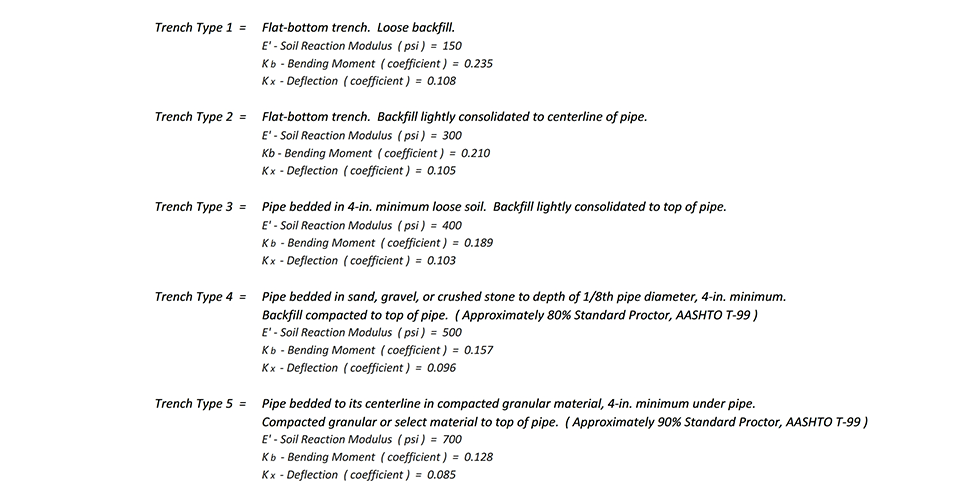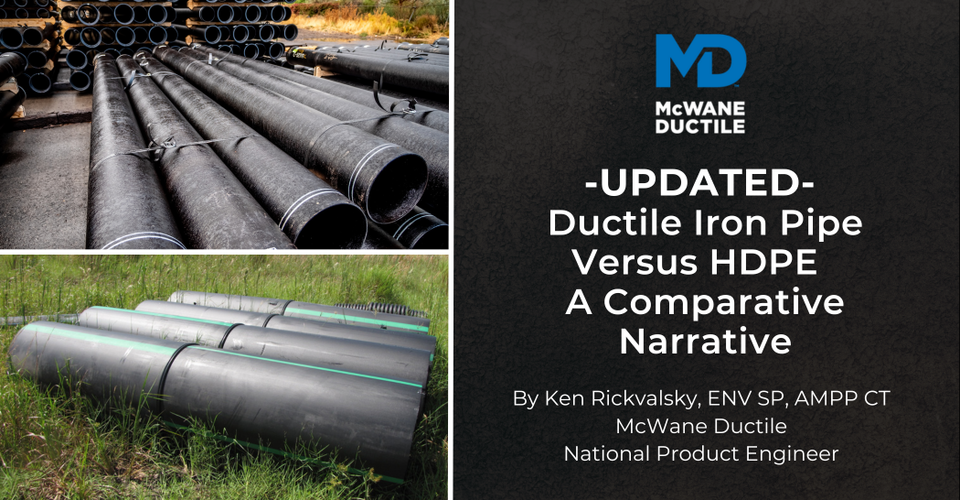Whenever the word "rating" is used regarding Ductile iron pipe (DI pipe), a 100-psi surge allowance and a safety factor of 2.0 are consistently included for all wall classes. This leads to conservative yet versatile designs for the long-term performance of utility pipelines of all kinds in various or changing conditions. Hence the basic universal rating for DI pipe is 350-psi which equates to a minimum of 900-psi of hydrostatic pressure containment within the pipeline.
Class Evolution
The development of various wall classes for Ductile iron pipe evolved across several decades as product improvements advanced. This progression of options is well-covered in previous articles published by McWane Ductile, such as What's the Difference Between Pressure Class and Thickness Class Pipe? | McWane Ductile by Jeremy Gwin in 2018 and What Did I Dig Up - Gray Iron or Ductile Iron Pipe? | McWane Ductile by Ken Rickvalsky earlier in 2021. Both are available for free in the Learning Library / Iron Strong Blog at McWane Ductile | Manufacturers of Quality Waterworks Products.
The most straightforward summary of both articles combined would be, if the Ductile iron industry were an ice cream shop, it would have offered just seven flavors before 1992, known as Thickness Classes.
But now, there are 12 flavors, including the five standard Pressure Classes of 150, 200, 250, 300, and 350. In diameters above 12-inches, Pressure Class designations are sprinkled in-between the better-known Thickness Classes, offering a closer fit to actual need, whether that need is governed by internal pressure or external loading.
Pressure Class (PC) 200 is not available until a diameter of 24-inches, while Pressure Class 150 enters the matrix of available walls at the 30-inch diameter. This article takes all this one step further and addresses some confusion in the marketplace regarding joint ratings versus barrel ratings.
Barrels
Fundamentally, there is no difference in the pressure rating between Ductile iron Thickness Class and Pressure Class pipes so long as the wall of the pipe itself meets or exceeds the minimum wall of a PC 350 or Thickness Class 50 through 56 pipes. Implementing the standard surge allowance and safety factor gets you to a 900-psi fluid pressure containment value.
The AWWA C150 Thickness Design standard for Ductile iron pipe designates the worst (thickest of 3 net wall designs) as the governor of pipe wall selection, with said independent designs being internal pressure, bending stress, and barrel deflection. Pressure Class pipe wall thickness is computed solely by the internal hydrostatic pressure involved, i.e., just 1 of the three standardized designs.
Yet, given the innate strength and durability of Ductile iron itself and the inclusion of additional standardized iron amounts to the wall covering service allowance and casting tolerance, most Pressure Class pipes are dually deserving for certain external loading conditions. See for yourself at the Thickness Calculator in the McWane Pocket Engineer Thickness Calculator (mcwane.com).
Outlining the barrels available just by the numbers for any diameter would list as follows:
- Thickness Class 50–56: all designated as 350-psi = (350 +100) x 2.0 = 900-psi
- Pressure Class 350: designated as 350-psi = (350 + 100) x 2.0 = 900-psi
- Pressure Class 300: designated as 300-psi = (300 + 100) x 2.0 = 800-psi
- Pressure Class 250: designated as 250-psi = (250 + 100) x 2.0 = 700-psi
- Pressure Class 200: designated as 200-psi = (200 + 100) x 2.0 = 600-psi
- Pressure Class 150: designated as 150-psi = (150 + 100) x 2.0 = 500-psi
From this data, you can understand why the hydrostatic test performed on every piece of pipe individually during the manufacturing process, regardless of pipe size or wall class, is performed to a minimum of 500-psi.
The actual metal wall for each pipe as manufactured includes the additional metal adders for service and casting considerations, up to 0.15-inches in total "extra metal" in most diameters. Thereby, the actual "working values" for these pipe walls, as computed with the universal hoop stress equation, can increase dramatically.
See below for 30-inch pipe as an example:
- 30-inch Thickness Class 52: designated as 350-psi = 0.47-inches = 1,234-psi
- 30-inch Pressure Class 350: designated as 350-psi = 0.49 inches = 1,286-psi
- 30-inch Pressure Class 300: designated as 300-psi = 0.45-inches = 1,181-psi
- 30-inch Pressure Class 250: designated as 250-psi = 0.42-inches = 1,103-psi
- 30-icnh Pressure Class 200: designated as 200-psi = 0.38-inches = 998-psi
- 30-inch Pressure Class 150: designated as 150-psi = 0.34-inches = 893-psi
Additionally, within the diameters of 3-inch through 36-inch for DI pipe, there are four instances where Pressure and Thickness Classes share identical nominal walls, namely 3-inch 350/51, 6-inch 350/50, 16-inch 350/50, and 20-inch 300/50.
For 12-inch and smaller diameters, there is only 1 Pressure Class available, 350, and it varies by no more than 0.03 inches in the nominal wall from the closest Thickness Class.
Joints
While the as-cast bell section of any Ductile iron pipe is the thickest and sturdiest portion of a given pipe, its combination into a finished joint with a more flexible spigot end governs the joint's rating, which may vary when involving larger diameters of pipe
The discussion on joints is much simpler than that of barrel ratings. Traditionally, Ductile iron pipe and fitting manufacturers have standardized to a joint rating of 350-psi for diameters 3-inch through 24-inch and 250-psi for 30-inch and above. This is primarily due to the increased flexibility of spigots within such large diameter joints and most notably restrained joint arrangements. This still affords a minimum of 700-psi operating value against hydrostatic pressure for the 250-psi rated joints and 900-psi for the 350-psi diameters.
Some designers have requested to limit a joint's potential rating to that of the "parent" barrel involved, which in the least case would be 150-psi or 500-psi on a gauge.
Most water systems in the United States operate at working pressures of less than 100-psi, so Ductile iron's "worst-case" 500-psi minimum provides far more resilience than will ever be needed in most if not all water distribution or transmission systems. Alternate thermoplastic-based utility pipe materials offered today generally are not rated, safety factors included, beyond 300-psi regardless of diameter or wall thickness. Most are less than 250-psi rated.
It is important to note that Ductile iron pipe joints also offer incredible resistance to infiltration of water or other fluids through the joint and never through the pipe wall itself. DI joints are tested and certified resist to an infiltration pressure of 430-psi at the rubber-gasket joint, which equates to nearly a 1,000-foot column of water pressing upon it.
These standard DI joints also reliably resist a 14-psi negative air pressure (-1 ATM vacuum/siphon). Sturdy beyond any practical need.
Conclusion
It is rare if ever, to find an installed condition for which Ductile iron pipe is not suitable or sufficient. The combination of available wall classes and positive interactions with the five standardized trenches utilized make Ductile iron pipe ideal for even the most arduous conditions.
A partial list would include:
- high-pressure applications,
- deep installations (up to 50-ft of cover),
- shallow installations (less than 2.5-ft of cover),
- above-ground exposure to UV light from the sun,
- sturdily strung along bridges or other aerial structures.
Ductile iron offers greater innate strength than any utility piping material by far, with proven duration across centuries and significant sustainability - as Ductile iron is a 95% recycled product - and is easily protected from corrosive environments when needed.
Together, Building Iron Strong Utilities for Generations is the sole goal. Contact your local McWane Ductile Sales Representative or affiliated Utility Distributor. They can assist or put you in touch with the appropriate Sales or Product Engineer to provide experienced hands-on assistance in the field if needed. You can find contact information for all at www.mcwaneDuctile.com.

